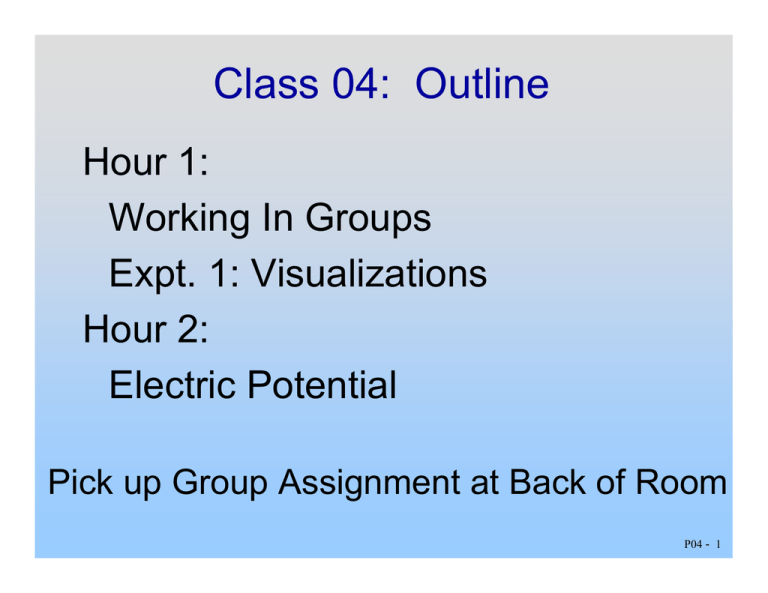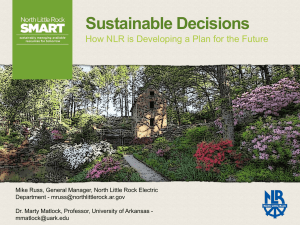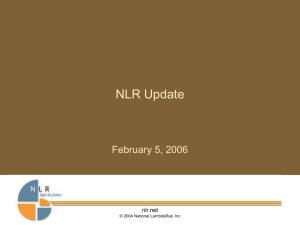Class 04: Outline Hour 1: Working In Groups Expt. 1: Visualizations
advertisement

Class 04: Outline Hour 1: Working In Groups Expt. 1: Visualizations Hour 2: Electric Potential Pick up Group Assignment at Back of Room P04 - 1 Groups P04 - 2 Advantages of Groups • Three heads are better than one • Don’t know? Ask your teammates • Do know? Teaching reinforces knowledge Leave no teammate behind! • Practice for real life – science and engineering require teamwork; learn to work with others P04 - What Groups Aren’t • A Free Ride We do much group based work (labs & Friday problem solving). Each individual must contribute and sign name to work If you don’t contribute (e.g. aren’t in class) you don’t get credit P04 - Group Isn’t Working Well? 1. Diagnose problem and solve it yourself -- Most prevalent MIT problem: free rider. 2. Talk to Grad TA 3. Talk to the teamwork consultant Don’t wait: Like most problems, teamwork problems get worse the longer you ignore them P04 - Introduce Yourselves Please discuss: • • • • • What is your experience in E&M? How do you see group working? What do you expect/want from class? What if someone doesn’t participate? What if someone doesn’t come to class? Try to articulate solutions to foreseeable problems now (write them down) P04 - Experiment 1: Visualizations Need experiment write-up from course packet. Turn in tear sheet at end of class Each GROUP hands in ONE tear sheet signed by each member of group P04 - 7 Last Time: Gravitational & Electric Fields P04 - 8 Gravity - Electricity CREATE: FEEL: Mass M Charge q (±) G M g = −G 2 rˆ r G q E = ke 2 rˆ r G G Fg = mg G G FE = qE This is easiest way to picture field P04 - 9 Potential Energy and Potential Start with Gravity P04 -10 Gravity: Force and Work Gravitational Force on m due to M: G Mm Fg = −G 2 rˆ r Work done by gravity moving m from A to B: Wg = ∫ B A G G Fg ⋅ d s PATH INTEGRAL P04 -11 Work Done by Earth’s Gravity Work done by gravity moving m from A to B: G G Wg = ∫ Fg ⋅ d s B ( GMm ⎞ ⎛ = ∫ ⎜ − 2 rˆ ⎟ ⋅ dr rˆ + rdθ θˆ r ⎠ A⎝ ) rB GMm ⎤ GMm ⎡ = ∫ − 2 dr = r ⎢⎣ r ⎥⎦ r rA ⎛ 1 1 ⎞ = GMm ⎜ − ⎟ ⎝ rB rA ⎠ rB A What is the sign moving from rA to rB? P04 -12 Work Near Earth’s Surface G GM G roughly constant: g ≈ − 2 yˆ = − g yˆ rE Work done by gravity moving m from A to B: G B G G Wg = ∫ Fg ⋅ d s = ∫ ( − mg yˆ ) ⋅ d s A yB = − ∫ mgdy = − mg ( yB − y A ) yA Wg depends only on endpoints – not on path taken – Conservative Force P04 -13 Potential Energy (Joules) ∆ U g = U B − U A = −∫ B A G G Fg ⋅ d s = − Wg = + Wext G GMm GMm ˆ (1) Fg = − r → Ug = − +U0 2 r r G → U g = mgy +U0 (2) Fg = − m g yˆ • U0: constant depending on reference point • Only potential difference ∆U has physical significance P04 -14 Gravitational Potential (Joules/kilogram) Define gravitational potential difference: ∆ Vg = ∆U g m = −∫ B A G BG G G (Fg / m) ⋅ d s = − ∫ g ⋅ d s A G G Just as Fg → gN , ∆ U g → ∆ Vg N N N Force Field Energy Potential That is, two particle interaction Æ single particle effect P04 -15 PRS Question: Masses in Potentials P04 -16 Move to Electrostatics P04 -17 Gravity - Electrostatics Mass M Charge q (±) G M g = −G 2 rˆ r G G Fg = mg G q E = ke 2 rˆ r G G FE = qE Both forces are conservative, so… ∆ Vg = − ∫ ∆ U g = −∫ B A B A G G g⋅d s G G Fg ⋅ d s G G ∆ V = −∫ E ⋅ d s A B G G ∆ U = − ∫ FE ⋅ d s B A P04 -18 Potential & Energy G G ∆ V ≡ −∫ E ⋅ d s B Units: Joules/Coulomb = Volts A Work done to move q from A to B: Wext = ∆U = U B − U A = q ∆V Joules P04 -19 Potential: Summary Thus Far Charges CREATE PotentialG Landscapes G V (r ) = V0 + ∆ V ≡ V0 − r ∫ G G E⋅d s "0" P04 -20 Potential Landscape Positive Charge Negative Charge P04 -21 Potential: Summary Thus Far Charges CREATE PotentialG Landscapes G V (r ) = V0 + ∆ V ≡ V0 − r ∫ G G E⋅d s "0" Charges FEEL Potential Landscapes G G U ( r ) = qV ( r ) We work with ∆U (∆V) because only changes matter P04 -22 Potential Landscape Positive Charge Negative Charge P04 -23 3 PRS Questions: Potential & Potential Energy P04 -24 Creating Potentials: Two Examples P04 -25 Potential Created by Pt Charge ∆V = VB − VA = − ∫ B A G G E ⋅ ds B dr rˆ G = − ∫ kQ 2 ⋅ d s = − kQ ∫ 2 A A r r ⎛1 1⎞ = kQ ⎜ − ⎟ ⎝ rB rA ⎠ B Take V = 0 at r = ∞: kQ VPoint Charge (r ) = r G rˆ E = kQ 2 r G d s = dr rˆ + r dθ θˆ P04 -26 2 PRS Questions: Point Charge Potential P04 -27 Potential Landscape Positive Charge Negative Charge P04 -28 Deriving E from V P04 -29 Deriving E from V G G ∆ V = −∫ E ⋅ d s B A A = (x,y,z), B=(x+∆x,y,z) G ∆ s = ∆ x ˆi ( x +∆ x , y , z ) ∆V = − ∫ G G G G G E ⋅ d s ≅ −E ⋅ ∆ s = −E ⋅ (∆ x ˆi ) = − Ex ∆ x ( x, y, z ) ∆V ∂ V Ex = Rate of change in V Ex ≅ − →− ∆x ∂ x with y and z held constant P04 -30 Deriving E from V If we do all coordinates: G ⎛ ∂V ˆ ∂V ˆ ∂V ˆ ⎞ E = −⎜ i+ j+ k⎟ ∂y ∂z ⎠ ⎝ ∂x ⎛ ∂ ˆ ∂ ˆ ∂ ˆ⎞ = −⎜ i+ j + k ⎟V ∂y ∂z ⎠ ⎝ ∂x G E = −∇ V Gradient (del) operator: ∂ ˆ ∂ ˆ ∂ ˆ j+ k ∇≡ i+ ∂x ∂y ∂z P04 -31 In Class Problem From this plot of potential vs. position, create a plot of electric field vs. position Bonus: Is there charge somewhere? Where? P04 -32 Configuration Energy P04 -33 Configuration Energy How much energy to put two charges as pictured? 1) First charge is free 2) Second charge sees first: U12 = W2 = q2V1 = 1 q1q2 4πε o r12 P04 -34 Configuration Energy How much energy to put three charges as pictured? 1) Know how to do first two 2) Bring in third: q3 ⎛ q1 q2 ⎞ + W3 = q3 ( V1 + V2 ) = ⎜ ⎟ 4π ε 0 ⎝ r1 3 r2 3 ⎠ Total configuration energy: 1 ⎛ q1q2 q1q3 q2 q3 U = W2 + W3 = + + ⎜ r13 r23 4πε 0 ⎝ r12 ⎞ ⎟ = U12 + U13 + U 23 ⎠ P04 -35 In Class Problem What is the electric potential in volts at point P? How much energy in joules is required to put the three charges in the configuration pictured if they start out at infinity? Suppose you move a fourth change +3Q from infinity in to point P. How much energy does that require (joules)? P04 -36






